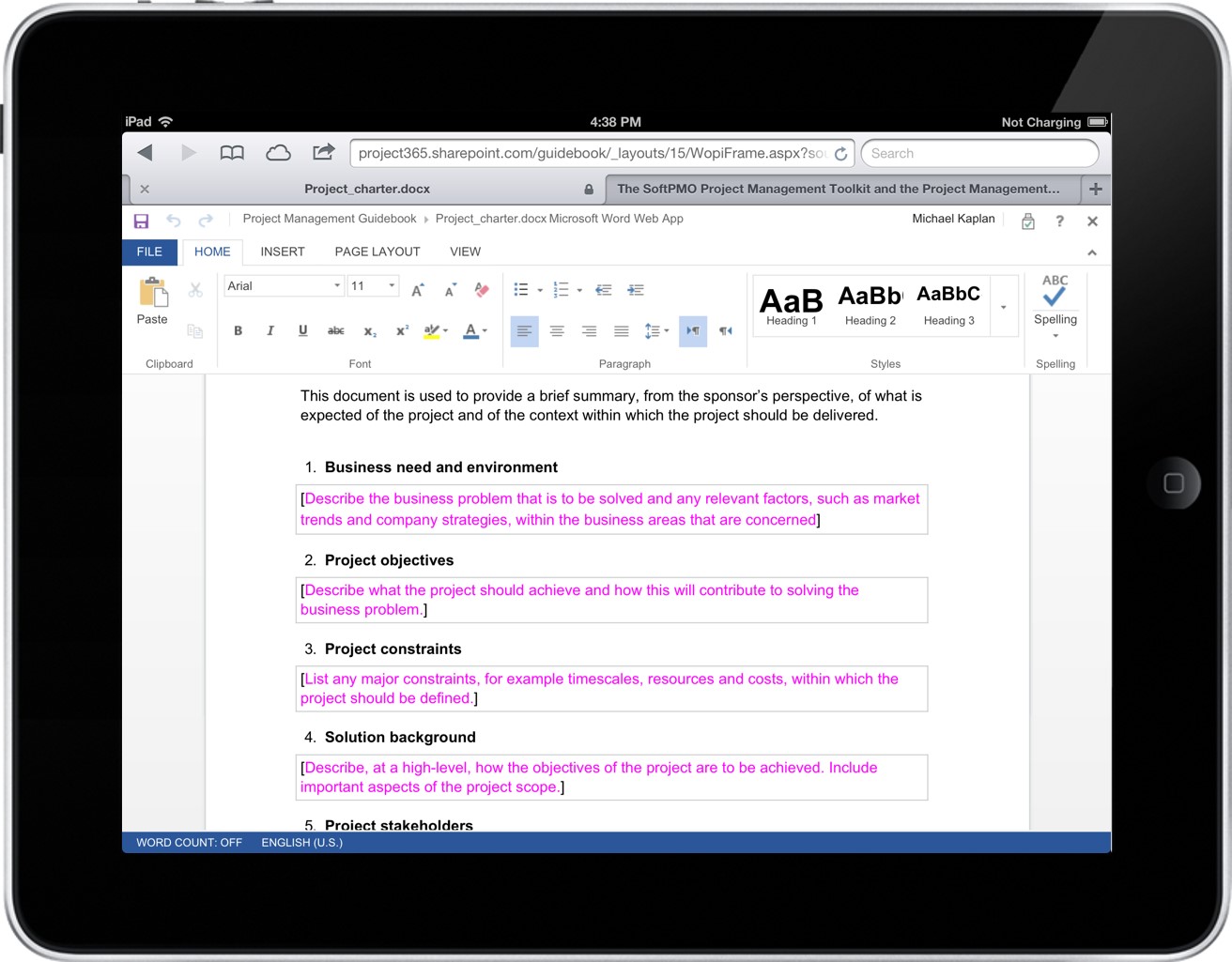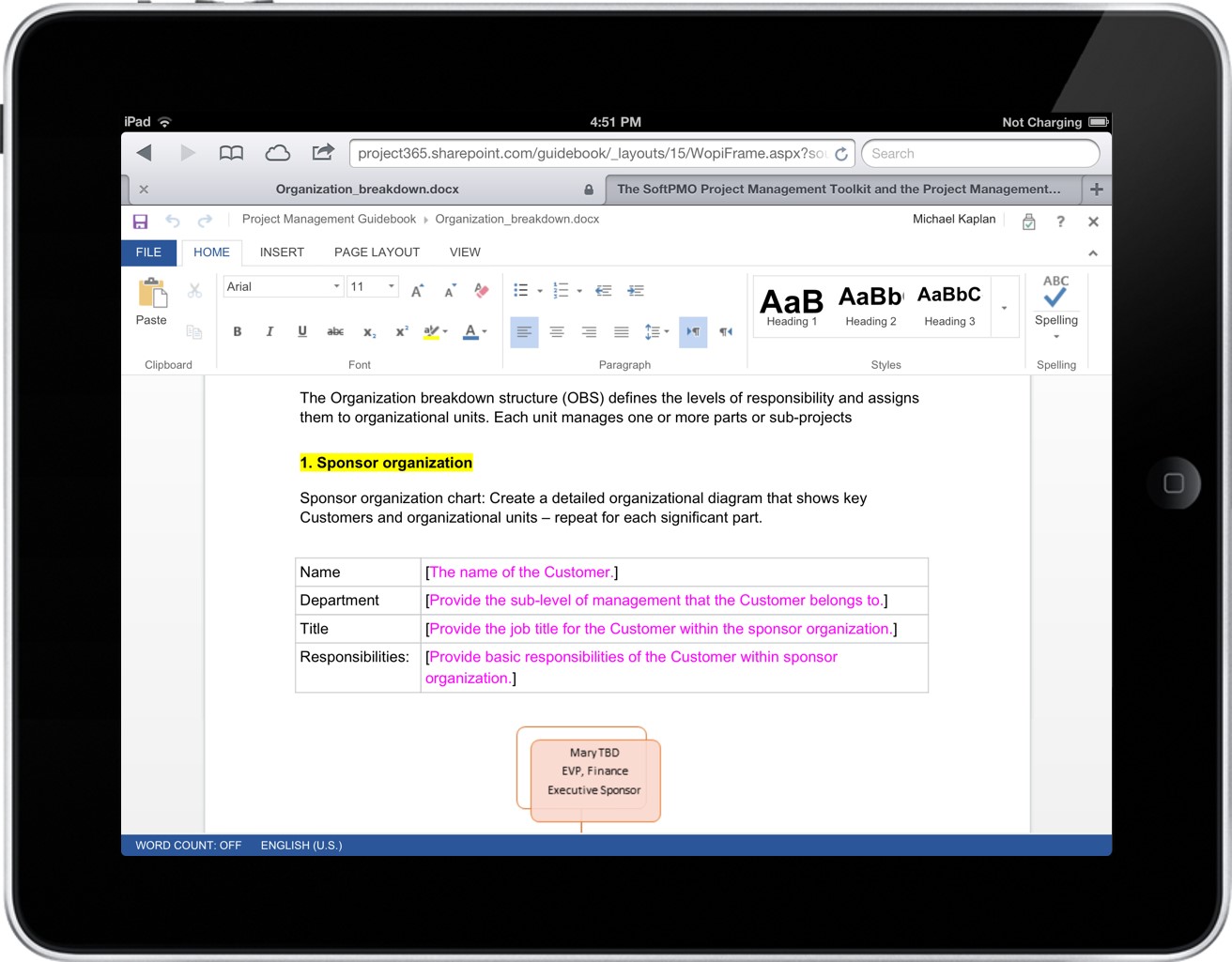The SoftPMO Project Management Templates
The SoftPMO Project Management Toolkit comes with 46 core planning and tracking templates that can be quickly and easily modified to meet the needs of every project.
Packaging options
The 46 core templates are divided into two groups, Basic (18 templates) and Advanced (28 templates). Basic templates define the core set of processes all project managers need to understand. Advanced templates focus on more complex project governance, work breakdown structure, scheduling, performance reporting, and program management issues.
Packaging groups
To help customers relate the SoftPMO templates to their existing project management methodology, we have mapped each template to the PMI’s Project Management Body of Knowledge (PMBOK®).
Template descriptions
Descriptions for the templates are used to identify the types of templates that are often used to manage a project and summarize why, how and when the products are created, updated, and used during the project.
Using the templates
Project managers that browse the guidebook, also use the Template descriptions, as a gateway point into the toolkit.
Table of templates
Project charterThe Project charter is issued by the sponsor to formally authorize the existence of a project and provides the project manager with authority to apply organizational resources to the project. #integration |
Project definitionThe Project definition contains the results of the Defining activities. Those results are used as a starting point to build the project plan. #scope |
Organization breakdownThe Organization breakdown structure outlines each organizational unit’s responsibilities toward completing the project. #hr |
Project governanceThis template provides a record of how decisions are made on the project. #hr |
Work product listA listing of all the work scheduled to be completed during a project, and a description of the proposed work. The Work Products are created for and used by the project. #scope |
Deliverable definitionDescribes deliverables, their components, delivery conditions, and acceptance criteria. #scope |
Human resource planLists number of people, HR category, and schedule for personnel assigned to the project. It is details roles and responsibilities, facilities required by personnel, team development, training sessions and other team-related activities. #hr |
Product breakdownA description of work products, by hierarchy of components and constituent parts. #scope |
Project scheduleThe timeline for the project. Defines organizational unit milestones, start and finish dates, interdependencies between organizational units, and which unit is responsible for which work products. Presented in a phased task and activities format. Encompasses entire scope of the project. #time |
Risk definitionDescribes risks associated with the project. Usually presented with probability of occurrence, qualitative description, and quantitative prediction of outcomes if triggered. #risk |
Milestone listContains a sequenced summary of main events (key milestones) planned throughout a project. Milestones provide an easy way to break the project down to sub-component parts, making it more manageable. #time |
Work breakdownDescribes work to be completed, by hierarchy, from the level of an individual worker’s daily task to the team level work products to the project level milestones. #scope |
ContractA contract is a mutually binding agreement between parties to provide goods, services, or results in exchange for some form of payment. There may be more than two parties involved to a Contract. #procurement |
Supplier selection reportDetails how suppliers were selected. Includes selection criteria and results of selection process. #procurement |
Financial planContains tables showing the estimated and budgeted amounts for project expenditures and revenues separated into expenditure type and accounting timeline. #cost |
Risk management planA compilation of the project mitigation, contingency and related reserve plans for handling threats identified in the Risk definition template. Each individual plan addresses a single risk or a class of risks. Because a single risk or a class of risks can have more than one planned response (e.g., a risk can be addressed by both a mitigation and a contingency plan), there is one risk response plan (entry) in the Risk management plan for each planned response for each identified risk or a class of risks. #risk |
Procedures descriptionDescribes procedures followed to complete the project work, either directly or points to where the procedures are found. #quality |
Project quality planDescribes how the project team will ensure that all deliverables or work products will meet the required quality standards. #quality |
Technical planDescribes the technical environment structure and how to implement it, including timelines. #integration |
Project controls summaryDescribes plans and procedures that are used to manage the project. Also contains records of plan implementation and execution of procedures. It serves as a summary of the management methods and proof that they were followed. #quality |
Communications planDescribes how communications will occur throughout the project, including who is involved (stakeholders), what content is to be presented, what medium will be used (meeting or e-mail, for example), how often it will be communicated, and when it will be communicated. #communications |
Infrastructure reviewAssesses the effectiveness of the technical environment and identifies means of enhancement or improvement. #integration |
Operational scheduleA breakdown of the work by organizational unit into a timeline detailing the work packages and corresponding work items. Details individuals responsible for the work and resources required. #time |
Contact listA directory of how to contact various project resources and personnel. May include telephone, email, and address information. #hr |
Staff listBasic personnel data for assigned members of the project team. #hr |
Staff scheduleDetailed availability information for assigned project personnel. #hr |
Action control documentTracks unplanned work and is tracked by the project manager. Includes actions, who is assigned to the action, due date, and current status. #integration |
Asset inventoryA list of all physical resources assigned to the project, and who they are assigned to. #procurement |
Team charterDefines operational guidelines team will follow. Presented to the project team at commencement of project, usually at the “kickoff” meeting. Also presented to new members as they join the team. #integration |
Project status reportStatuses the project as detailed in the communication plan. #communications |
Individual status reportPeriodically statuses an individual’s project contributions, as required by the Communication plan. #communications |
Contractor status reportPeriodically statuses an contractor’s project contributions, as required by the Communication plan. #communications |
Change requestProvides information necessary for the control board to handle unforeseen changes to the projects. It includes a description of the reasons for the change, how it will affect the project, and how it will be implemented and monitored. #integration |
Quality reviewCollects data used to prepare, perform, and audit a quality review. May also apply to a business or management review, and contains information required to follow-up on results. #quality |
Meeting documentationCollects information to organize a meeting and record the results of a meeting. #communications |
Expenditure logRecords all expenditures of the project. Entries include expenditure type, amount, date, authorized agent, reference to budget items, and approval authentication (if required). #cost |
Issue documentLists issues (concerns) as they occur throughout the project. #integration |
Event logNotable events and constraints requiring later reference or analysis. #communications |
Incident documentDocuments events in which a Sponsor or supplier is not meeting an obligation under the Agreement, excluding defects. Identifies all the compliance incidents, their owners, the Sponsors or suppliers involved, and their individual status. #quality |
Deliverable controlTracks deliverables from release to acceptance. #integration |
Findings logRecords identification and resolution of findings. #communications |
Risk occurrenceRecords risks as they occur. Links to action control documents used to respond to the risk. #risk |
Change orderContains information needed to implement approved change requests. #integration |
Situation analysisContains preparation documents for a situation analysis, the situation analysis, and resulting reports. #integration |
Correspondence logRecords all important communications and information broadcasts that occur during the project lifetime. #communications |
Closure reportSummarizes project and lessons learned. Identifies materials that may be reused. #quality |















